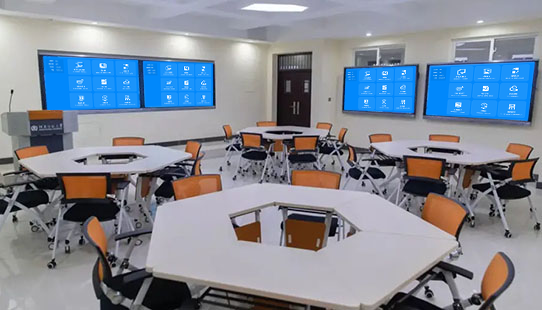Interactive Classrooms: A Solution to Bring Classrooms to Life
This interactive classroom solution doesn’t require complex equipment. By using device linkage and lightweight functions, it ensures that a teacher’s lessons aren’t rigid and students aren’t passive, which makes the classroom highly interactive.
Seamless Device Linkage, Anytime Interaction
A teacher’s tablet and phone can connect directly to the classroom’s main screen. They can scan a QR code to mirror courseware in 3 seconds and then walk to a desk to use their finger to turn pages and highlight key points. When teaching ancient poetry, they can highlight a few lines of a poem in red. When teaching a formula, they can circle the key steps. Students just have to look up to see everything clearly.
Students’ tablets and laptops can also connect to the large screen. If someone wants to share their problem-solving process, they just tap to mirror their draft. When a group discussion is finished, each group’s conclusion can be displayed in a split-screen view on the main screen, so there’s no need to pass notebooks around.
Diverse Interactive Options, No More Boring Lessons
In class, you can have “instant quizzes.” A teacher can ask a multiple-choice question, and students can select an answer on their device. The large screen will show the results in real time, so it’s clear at a glance who got it wrong and which question was most debated. The teacher can then explain the common mistakes more thoroughly.
Even in a lab class, it’s more convenient. A visualizer can be used to project the reaction in a test tube or the wiring on a circuit board onto the large screen, so students in the back don’t have to crowd the front. If a student gets stuck during an experiment, they can take a photo of their work and mirror it to the large screen, and the teacher can point to the photo and explain the issue on the spot. It’s much easier than having to crowd around to see.
Hassle-Free Wrap-Up, Effective Results
Records of the quizzes and mirrored student homework are automatically saved to a class library. After class, students can scan a QR code to review the content, and a teacher can look at the records to see who didn’t keep up. The devices are easy to use—just connect to the network. An administrator can also check the device status remotely, so there’s no need to visit the classroom every day. It’s a convenient solution for everyday use.
With this kind of interactive classroom, a teacher gets feedback, and students get to participate, which naturally creates a different classroom atmosphere.